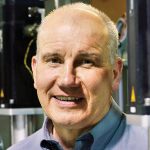
Bioenergy and Biofuels
Biomass is an increasingly important renewable energy source that has the potential to reduce dependence on hydrocarbon-based energy sources. This module presents an overview of the use of biomass to produce bioenergy with emphasis on bioethanol, and an explanation of the main steps in producing ethanol from wood.
Learning Objectives
After viewing the module presentations and laboratory videos, users should be able to:
- Explain how bioenergy and biofuels are renewable options, if grown and produced sustainably, and that bioenergy and biofuels can displace a substantial amount of conventional energy sources such as oil, gas and coal.
- Describe the importance of biomass as a renewable resource for both energy production generally, and transportation fuels specifically.
- Identify several conversion technologies (that use various sources of biomass) and their different advantages and disadvantages (biochemically and thermochemically produced options are compared). Explain that technologies have reached different commercialization or “technical maturity” levels (first and second generation biofuels).
- Explain why by-products improve the economic viability of production (the biorefinery concept).
- Identify ethanol as one of the transportation biofuel options and explain why.
- Describe the three major steps in ethanol production from wood biomass (pretreatment, hydrolysis and fermentation) and identify key procedures and research questions for each step.
Presenters
Listen to each Presenter respond to the question: How did I get interested in this area of study? by clicking on their photos.

Dr. Richard Chandra, Research Associate
For more information about the Presenters, click on their names:
Dr.Saddler Ms.Hanova Dr.Chandra Dr.Arantes Dr.Sella_Kapu
Module Resources
Presentations
![]() Overview: Importance of Bioenergy and Biofuels
Overview: Importance of Bioenergy and Biofuels
There are two lecturers in this Presentation. Dr. Jack Saddler discusses the history of the growth of bioenergy in general and of biofuels (using biomass as a medium) in particular. He gives a very brief description of the various bioenergy technologies and then focuses on explaining the current context for research into biofuels. Ms. Jana Hanova, the network manager for Task 39 (Commercializing liquid biofuels) of the International Energy Agency (IEA), describes the purpose, work and outputs of this task group.
![]() Process 1: Pretreatment of Wood
Process 1: Pretreatment of Wood
Dr. Richard Chandra talks about the first step in the conversion of wood to biofuels. Pretreatment is a physical and/or chemical process that breaks down the biomass so that it is more accessible to the enzymes which carry out hydrolysis. The objective is to put enough energy into the pretreatment process so as to effectively separate the key components of the wood: cellulose, hemicellulose and lignin, without their destruction. The challenge is to find a pretreatment process that produces the maximum recovery, enables easy hydrolysis, is useable with diverse biomass and is relatively inexpensive.
![]() Process 2: Hydrolysis of Cellulose to Simple Sugars
Process 2: Hydrolysis of Cellulose to Simple Sugars
In his lecture, “enzymatic hydrolysis of lignocellulostic biomass”, Dr. Valdeir Arantes explains how pretreated wood (“mush”) is converted to simple, monomeric fermentable sugars such as glucose. Enzymes, isolated from the same fungi that work to breakdown trees in nature, are used as catalysts to speed up this hydrolysis (breakdown) of cellulose. Tricoderma reesei, for example, is an important fungi from which such enzymes are extracted.
Dr. Nuwan Sella Kapu explains how sugars are fermented to produce the biofuel ethanol. The processing of biomass such as wood (i.e. a lignocellulose biomass) produces five monosaccharides that are contained in a liquid and a solid fraction. Researchers are trying to determine which strains of the Saccharomyces cerevisiae yeast are best able to ferment all five sugars and be able to tolerate the high levels of fermentation inhibitors that are found in the liquid fraction.
Laboratory Videos
 Laboratory 1: Wood to Mush
Laboratory 1: Wood to Mush
This lab video takes place in the Process Development Unit. As wood is meant to stay together, large amounts of energy are required to break it apart. First the wood is chipped so as to increase the surface area and then it is added to the steam gun. The boiler supplies high pressure steam (~200°C) and the process takes from 2 to 10 minutes. Both solid (cellulose- & lignin-rich) and liquid (hemicellulose-rich) products accumulate in the collection vessel.
 Laboratory 2: Mush to Sugars
Laboratory 2: Mush to SugarsThis lab video is from the Biofuels laboratory. A sample of the pretreated biomass “mush” is added to a flask along with, primarily, cellulase enzymes. These enzymes are proteins, derived from fungi, which speed up the breakdown of the cellulose chains. The materials are incubated for 48 to 72 hours after which they are analyzed using an HPLC (high performance liquid chromatography) machine that determines how much and what kinds of sugars have been produced.
 Laboratory 3: Sugars to Ethanol
Laboratory 3: Sugars to EthanolThis lab video takes place in the Biofuels Microbiology lab in a laminar flow cabinet so as to avoid sample contamination. The hydrolysate from lab 2 is mixed with the yeast and the sample is incubated. Samples are taken at regular intervals to analyze for ethanol using gas chromatography and for sugars using HPLC. Once a suitable yeast strain is determined, greater amounts of ethanol can be produced using 40 litre and larger fermenters.
Other Resources
- BC Bioenergy Network
- UBC Forest Products Biotech.& Bioenergy homepage
- International Energy Agency — Bioenergy
- International Energy Agency — Bioenergy, Task 39
- U.S. Dept. of Energy, Biomass Program – Information Resources
- U.S. Energy Information Administration
Potential Questions for use by Instructors
- One could argue that making biofuels from cellulosic biomass is not economically viable. Why is it still an important area to research?
- List the 3 main steps in producing ethanol from wood. Explain the basic concepts associated with and output of each step. What is (are) the key researach question(s) in each step?




